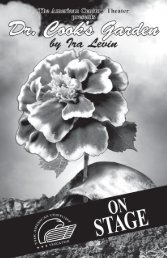Stage Door - The American Century Theater
Stage Door - The American Century Theater
Stage Door - The American Century Theater
You also want an ePaper? Increase the reach of your titles
YUMPU automatically turns print PDFs into web optimized ePapers that Google loves.
women who were thrust into homelessness for the first time. Some ended up<br />
in shelters, but the rest sought other solutions, though government agencies<br />
provided few alternatives. As an unemployed female college graduate told a<br />
social worker in 1932, “Having an address is a luxury just now.”<br />
<strong>The</strong>se newly destitute women drifted from one unemployment office to the<br />
next, resting in Grand Central or Pennsylvania Station, riding the subway all<br />
night (known as staying in the “five-cent room”), or sleeping in the park.<br />
<strong>The</strong>y ate in penny kitchens. Fearful and ashamed to ask for charity, these<br />
women could be on the verge of starvation before they sought help. <strong>The</strong>y<br />
were, according to one report, often the “saddest and most difficult to help.”<br />
<strong>The</strong>se women “starved slowly in furnished rooms. <strong>The</strong>y sold their furniture,<br />
their clothes, and then their bodies.”<br />
Gender stereotypes of the day often dictated that women return to the rural<br />
homestead during times of trouble, to help out around the home and be given<br />
shelter, supposedly in family homes large enough to accommodate everyone.<br />
But the reality, especially in cities like New York, was not so idyllic. <strong>The</strong><br />
family often lived in a strained, overburdened, overcrowded household in a<br />
small apartment that often contained severe domestic troubles of its own.<br />
Returning home was often not an option at all. Few had rural roots to fall<br />
back upon, and those who did often looked on that course as a humiliating<br />
admission of failure and inadequacy. <strong>The</strong> new, emancipated woman of the<br />
Roaring Twenties was now left without a respectable face as the Depression<br />
deepened.<br />
Over half of these job-hunting women had never married, while others were<br />
divorced, deserted, separated, or widowed. Some had dependent parents and<br />
siblings who relied on them for support. Some had children who were living<br />
with extended family. In New York, 85 percent of the women seeking work<br />
had been self-supporting only a few years earlier. Some had been<br />
unemployed for months and others, for a year or more. Once savings and<br />
insurance were used up, they tried their informal social networks. <strong>The</strong>se<br />
were quickly tapped out, if not already exhausted.<br />
For the most part, the tangible evidence of breadlines, Hoovervilles, and<br />
men selling apples on street corners did not contain images of urban women.<br />
Unemployment, hunger and homelessness were considered a man’s<br />
problem. In photographic images and news reports, destitute urban women<br />
seldom appear. Most of the New Deal work programs set up to help the<br />
unemployed focused on male workers.<br />
2

















